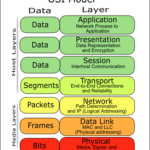In the rapidly evolving world of global supply chains, interoperability—the ability of systems, devices, and organizations to work together seamlessly—has become a critical factor for operational efficiency. By applying the ISO OSI (Open Systems Interconnection) seven layer model, traditionally used in networking, to logistics, businesses can achieve a structured framework that enhances communication, reduces friction, and improves collaboration throughout the supply chain.
Let’s examine how the OSI model can provide a plan for supply chain interoperability, breaking down logistics processes into manageable layers to ensure seamless integration and operational success.
Understanding the OSI Model in Networking
The ISO OSI model is a seven-layer abstraction that standardizes each interconnect of a networking system. Each layer serves a particular unique function and interfaces with the layers both above and below it. These seven layers are:
1. Physical Layer: Transmits data over a physical connection.
2. Data Link Layer: Handles data transfer between connected nodes.
3. Network Layer: Manages data routing.
4. Transport Layer: Ensures dependable data transfer.
5. Session Layer: Manages sessions between applications.
6. Presentation Layer: Translates between data formats.
7. Application Layer: Interfacing with end-user applications.
While designed for computer networks, this layered model can be adapted to supply chain systems to streamline communication and ensure compatibility across diverse technologies.
Applying the OSI Model to Supply Chain Interoperability
Mapping the OSI model to supply chain logistics offers a structured approach to identifying and addressing barriers to seamless integration. Here’s how each layer translates to the supply chain context:
1. Physical Layer: Material Flow
At the foundation of any supply chain is the physical movement of goods. This layer includes trucks, ships, warehouses, and other physical assets. Interoperability at this level involves ensuring that all hardware and equipment, such as conveyors or automated guided vehicles (AGVs), can communicate through standardized interfaces.
• Key Consideration: IoT sensors on shipping containers or pallets enable real-time tracking, ensuring visibility and coordination.
2. Data Link Layer: Local Communication
This layer focuses on the direct communication between devices within a localized environment, such as a warehouse or a port. Technologies like RFID (Radio Frequency Identification) and Bluetooth facilitate data exchange between devices.
• Key Consideration: Ensuring compatibility between devices and systems, such as ensuring RFID tags can be read by various scanners across facilities.
3. Network Layer: Routing Across the Supply Chain
In supply chains, this layer corresponds to the routing of goods and information across different nodes in the network. Logistics systems must ensure that information about shipments flows correctly between suppliers, distributors, and retailers.
• Key Consideration: Use of Electronic Data Interchange (EDI) and APIs to transmit order and shipment data across stakeholders.
4. Transport Layer: Reliable Delivery
The transport layer ensures that goods and information are delivered reliably, similar to how data packets are delivered in networking. In logistics, this means ensuring the integrity of shipments and the accuracy of delivery information.
• Key Consideration: Implementing blockchain technology for traceability and ensuring tamper-proof delivery records.
5. Session Layer: Coordination Between Systems
This layer facilitates the coordination between different applications or systems in the supply chain. For example, coordinating inventory management systems with demand forecasting tools.
• Key Consideration: Synchronizing enterprise resource planning (ERP) systems with warehouse management systems (WMS) and transportation management systems (TMS).
6. Presentation Layer: Data Standardization
In the supply chain, the presentation layer focuses on data translation and standardization. Different entities in the supply chain often use different data formats, which can lead to compatibility issues.
• Key Consideration: Utilizing standardized data formats like EDIFACT or JSON to ensure data consistency across systems.
7. Application Layer: End-User Access
The application layer corresponds to the user-facing systems in the supply chain, such as customer portals, supplier dashboards, and analytics tools. These interfaces must provide stakeholders with actionable insights and seamless access to critical data.
• Key Consideration: Implementing user-friendly applications and dashboards that integrate real-time data from multiple systems.
Benefits of Using the OSI Model for Supply Chain Interoperability
Applying the OSI model framework to logistics offers several advantages:
1. Layered Approach to Problem-Solving: Breaks down complex interoperability challenges into manageable layers, making it easier to identify and resolve issues.
2. Standardization: Encourages the use of standardized protocols and formats, reducing miscommunication and inefficiencies.
3. Improved Collaboration: Enhances coordination between diverse stakeholders, from suppliers and manufacturers to distributors and retailers.
4. Scalability: Provides a scalable structure that can adapt as supply chains grow and incorporate innovative technologies.
Real-World Examples of OSI-Inspired Supply Chain Interoperability
1. Amazon’s Robotics and IoT Integration
Amazon employs thousands of robots in its warehouses, which communicate using IoT devices. These devices operate on standardized protocols, ensuring that robots from different manufacturers work seamlessly together to optimize picking and packing processes.
2. Walmart’s Blockchain for Food Traceability
Walmart leverages blockchain technology to enhance food traceability. This corresponds to the transport and network layers, ensuring reliable and secure data transfer across all stakeholders in the supply chain.
3. Maersk and IBM’s TradeLens
TradeLens, a blockchain-based platform developed by Maersk and IBM, standardizes data formats and provides a unified dashboard for global shipping. This aligns with the session and application layers, enabling better coordination between shipping lines, ports, and customs authorities.
Conclusion
Interoperability is no longer optional in the modern supply chain. By adopting the OSI model as a framework, organizations can create a systematic approach to addressing compatibility issues, standardizing processes, and ensuring seamless communication across their logistics networks. This layered strategy not only enhances efficiency but also future-proofs supply chains against the complexities of a rapidly digitizing world.
As businesses continue to embrace technologies like IoT, blockchain, and AI, leveraging the OSI model for supply chain interoperability could be the key to unlocking new levels of operational excellence.
The post Interoperability in the Supply Chain: Leveraging the OSI Model for Seamless Logistics appeared first on Logistics Viewpoints.
